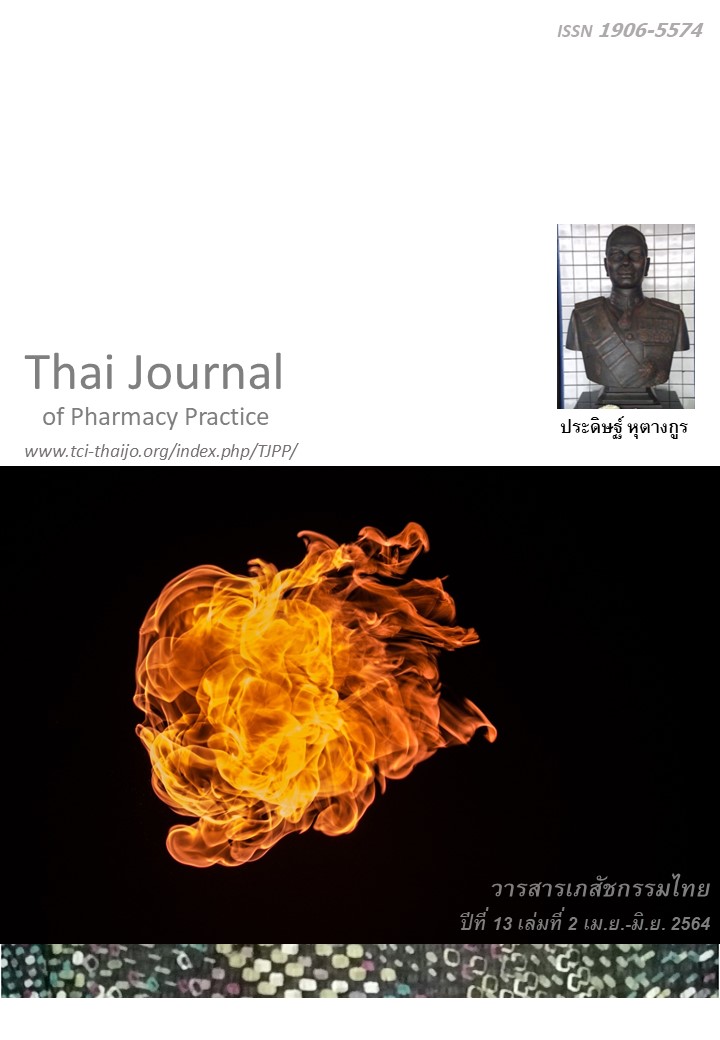การศึกษาเชิงพรรณนาแบบย้อนหลังเกี่ยวกับการใช้ยาโคลิสตินในโรงพยาบาลขอนแก่น
Main Article Content
บทคัดย่อ
วัตถุประสงค์: เพื่อประเมินการใช้ยา colistin ตามเกณฑ์ที่กำหนด วิธีการ: การวิจัยนี้เป็นศึกษาแบบย้อนหลังการศึกษาเก็บข้อมูลจากเวชระเบียนของผู้ป่วยในของโรงพยาบาลขอนแก่นระหว่างเดือนตุลาคม พ.ศ.2558 ถึงกันยายน พ.ศ. 2559 และได้รับการรักษาด้วยยา colistin แบบฉีดเข้าหลอดเลือดดำผู้วิจัยประเมินการใช้ยาของแพทย์ใน 5 ด้าน คือ ข้อบ่งใช้ แบบแผนการให้และขนาดการใช้กระบวนการก่อนและระหว่างการใช้ยา การเกิดพิษต่อไต และผลลัพธ์ทางคลินิกโดยใช้เกณฑ์ของโรงพยาบาล ผลการศึกษา: จากข้อมูลการสั่งใช้ยา 623 ครั้งในผู้ป่วย 557 คนที่ได้รับยา colistin พบว่า ส่วนใหญ่เป็นเพศชาย (ร้อยละ 67.90) อายุเฉลี่ย 57 ปี มีโรคประจำตัวร่วมร้อยละ 74.8 ใช้เครื่องช่วยหายใจร้อยละ 81.5 นอนรักษาในหอผู้ป่วยหนักร้อยละ 52.2 ใช้ยาต้านจุลชีพก่อนเริ่มใช้ยา colistin ร้อยละ 94.7 ใช้ยา colistin ในข้อบ่งชี้ปอดอักเสบจากการติดเชื้อในโรงพยาบาลหรือใส่เครื่องช่วยหายใจมากที่สุดร้อยละ 82.2 ให้ยา colistin ร่วมกับยาที่อาจเกิดพิษต่อไตร้อยละ 30.2 การประเมินการใช้ยา colistin พบว่า แพทย์เริ่มใช้ยาเมื่อมีผลเพาะเชื้อและผลความไวของยาร้อยละ 56.0 ให้ยา loading dose ก่อนร้อยละ 68.2 ขนาดยา colistin สอดคล้องกับเกณฑ์ขนาดยาที่ใช้ศึกษาร้อยละ 78.5 มีกระบวนการก่อนเริ่มยาและระหว่างให้ยาเหมาะสมร้อยละ 58.3 ถึง 75.9 ใช้ยา colistin เฉลี่ย 10±6.58 วัน ผลลัพธ์ทางคลินิกดีขึ้นตามเกณฑ์ในการศึกษาร้อยละ 85.1 แต่อาการทางคลินิกดีขึ้นเมื่อจำหน่ายร้อยละ 39.33 สรุป: การสั่งใช้ยา colistin ในโรงพยาบาลขอนแก่นมีความเหมาะสมในเรื่องข้อบ่งใช้ของยาการให้ loading dose ในครั้งแรกขนาดยา loading dose ขนาดของ maintenance dose ระยะห่างของการใช้ยาแต่ละครั้งกระบวนการก่อนเริ่มยาและระหว่างให้ยาการจัดการปัญหาด้านพิษต่อไตและผลลัพธ์ทางคลินิก แต่ยังไม่มีความเหมาะสมในแง่ของระยะเวลาในการใช้ยา colistin
Article Details
ผลการวิจัยและความคิดเห็นที่ปรากฏในบทความถือเป็นความคิดเห็นและอยู่ในความรับผิดชอบของผู้นิพนธ์ มิใช่ความเห็นหรือความรับผิดชอบของกองบรรณาธิการ หรือคณะเภสัชศาสตร์ มหาวิทยาลัยสงขลานครินทร์ ทั้งนี้ไม่รวมความผิดพลาดอันเกิดจากการพิมพ์ บทความที่ได้รับการเผยแพร่โดยวารสารเภสัชกรรมไทยถือเป็นสิทธิ์ของวารสารฯ
เอกสารอ้างอิง
O Neill J. Review on antimicrobial resistance. Antimi- crobial resistance: Tackling a crisis for the health and wealth of nations [online]. 2014 [cited Mar 6, 2020].Available from: www.amr-review.org/sites /default/files/AMRReviewPaper-Tacklingacrisisfor thehealthandwealthofnations_1.pdf.
Thamlikitkul V. A guide to the control and prevention of antimicrobial resistant bacteria in the hospital. Nonthaburi: Health Systems Research Institute; 2015.
National Antimicrobial Resistance Surveillance Center Thailand (NARST). Antimicrobial resistance 2000-2017 [online]. 2017 [cited Mar 7, 2020]. Available from: www.narst.dmsc.moph.go.th
Chatsuwan T, Paveenkittiporn W, Dubbs P. Activity of antimicrobial combinations against multidrug-resistant Acinetobacter baumannii and the associa- tion with resistance mechanisms: implication for treatment of infections caused by multidrug-resistant isolates [online]. 2017 [cited Mar 6, 2020]. Available from: www.cuir.car.chula.ac.th/hadle/123 456789/62952
Giamarellou H, Poulakou G. Multidrug-resistant gram -negative infections: what are the treatment options ? Drugs 2009; 69: 1879-901.
Fishbain J, Peleg AY. Treatment of Acinetobacter infections. Clin Infect Dis 2010; 51: 79-84.
Thamlikitkul V. Colistin: Antimicrobial for treatment resistant gram negative bacterial infection. Siriraj Medical Bulletin. 2008; 1: 152-8.
Santimaleeworagun W. Medication error about colistin dosage. Thai Journal of Hospital Pharmacy. 2011; 21 : 243-51.
Falagas ME Kasiakou SK. Use of international units when dosing colistin will help decrease confusion related to various formulations of the drug around the world. Antimicrob Agents Chemother 2006; 50: 2274-5.
Michalopoulos A Karatza D. Multidrug resistant gram-negative infections: the use of colistin [online]. 2014 [cited Mar 6, 2020]. Available from: www.doi. org/10.1586/eri.10.88
Ordooei Javan A, Shokouhi S, Sahraei Z.A review on colistin nephrotoxicity.Eur J Clin Pharmacol 2015; 71: 801-10.
Gilbert DN, Chambers HF, Eliopoulos GM, SaagMS, Pavia AT, Black D, et al. The Sanford guideline to antimicrobial therapy 2016. 46th ed. Sperryville: Antimicrobial Therapy; 2016. p112.
Nation RL, Garonzik SM, Thamlikitkul V, et al. Dosing guidance for intravenous colistin in critically ill. Clin Infect Dis. 2017; 64: 565-71.
Maharat Nakhon Ratchasima Hospital. The rational drug use RDU [online]. 2016 [cited Sep 15, 2016]. Available from: www.medkorat.in.th/admin/ckfind er/userfiles/files/AMRJan9-12.pdf
Kellum JA, Lameire N, Aspelin P, Macleod AM, Barsoum RS, Mehta RL, et al. Kidney Disease Improving Global Outcomes (KDIGO) clinical practice guideline for acute kidney injury. Kidney Inter Suppl 2012; 2: 8-12.
Reechaipichitkul W. HAP, VAP and HCAP guide-lines : from guidelines to clinical practice. Srinagarin Medical Journal. 2010: 25 Suppl 1; 87-94.
Koomanachai P, Tiengrim S, Kiratisin P, Thamlikit- kul V. Effcacy and safety of colistin (colistimethate sodium) for therapy of infectious caused by multidrug resistant Pseudomonas aeruginosa and Acinetobacter baumannii in Siriraj Hospital, Bangkok, Thailand. Int J Infect Dis 2007; 11: 402-6
Kanankaeng W, Sriphong P. Regimens and clinical outcomes of antimicrobial uses in hospital-acquired pneumonia caused by drug resistant Acinetobacter baumannii.Thai Journal of Pharmacy Practice 2019 ; 11 : 470–82.
Anusornsangiam W, Somsak N, Rahong W, Chaiya song S, Chaiyasong C. Incidence of adverse effect by colistin used in hospital. Journal of Science and Technology Mahasarakham University. 2017; 36: 589–96.
Wongsampan S, Jittsue A, Santiyanon N, Yeepu S, Ariyawithaya K, Kitjakarn N. Efficacy and safety of the treatment of Acinetobacter baumannii Infection with colistin injection.Thai Journal of Pharmacy Practice 2018; 10: 375–81.
Yahav D, Farbman L, Leibovici L, Paul M. Colistin: new lessons on an old antibiotic. Clin Microbiol Infect 2012; 18: 18-29.


